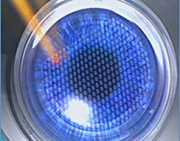Femtosecond Laser Lasik
EYE DAY CLINIC uses Femtosecond Laser Lasik, the most modern method in the world for the correction of refractive errors.

Femto Lasik
With a pulsing Femtosecond laser, we create a high-precision flap, replacing the traditional methods which used a “blade”.
The method’s high effectiveness and safety make it an ideal solution for the correction of refractive errors.
Surgery only takes a few minutes and the patient does not experience any significant discomfort.
Medication is only required for ten days and the patient’s vision is very good from day one, allowing them to return to their everyday activities right away.
Advantages of the Femtosecond Laser Lasik method
The advantages of the Femtosecond Laser Lasik method are:
The surgery is painless and only lasts a few minutes
Vision restoration and stabilization is very fast
The degree of predictability is high.
The duration of the post-operative treatment is very short.

It is very important for our refractive surgery department to ensure that the refractive surgery candidate understands that not all cases are suitable for the Femtosecond Laser Lasik method. This method cannot be performed in the following cases:
- Forme fruste keratoconus. Forme fruste keratoconus refers to an atypical or subclinical keratoconus, which suggests that the keratoconus has either not evolved or has stopped evolving quite early. The clinical signs of the disease are subtle and hard to diagnose. Therefore, the refractive surgeon must be especially careful with patients with unclear corneal topography or with patients who will require greater refractive correction, especially if they are also suffering from myopia.
- Thin corneas. Corneal pachymetry is a vital part of the pre-operative evaluation as patients with corneas with reduced thickness cannot have refractive surgery. The LASIK method requires a minimum residual thickness of the cornea after the scission of the flap of at least 250-300 μm10,11. EYE DAY CLINIC respects fully these safety limits.
- Autoimmune diseases. Patients with autoimmune diseases require greater attention during the preoperative evaluation as well as closer monitoring during the post-operative period. If a systemic disease is well regulated, in remission and without ocular manifestations, then there are no contraindications to performing the surgery. In any other case, we do not recommend the refractive surgery.
- Pupil size. The size of the pupil is a parameter that needs to be measured and should be taken under serious consideration during the preoperative evaluation at EYE DAY CLINIC, to avoid complications related with post-operative visual phenomena due to the difference in the diameters of the ablation zone and the pupil.
- Glaucoma. Patients with glaucoma should undergo a detailed preoperative evaluation and the course of treatment as well as the decision on performing a refractive surgery should be carefully examined. The PRK method should be used for patients with advanced glaucoma be used, while patients who have had glaucoma valve implant surgery should avoid refractive surgery.
